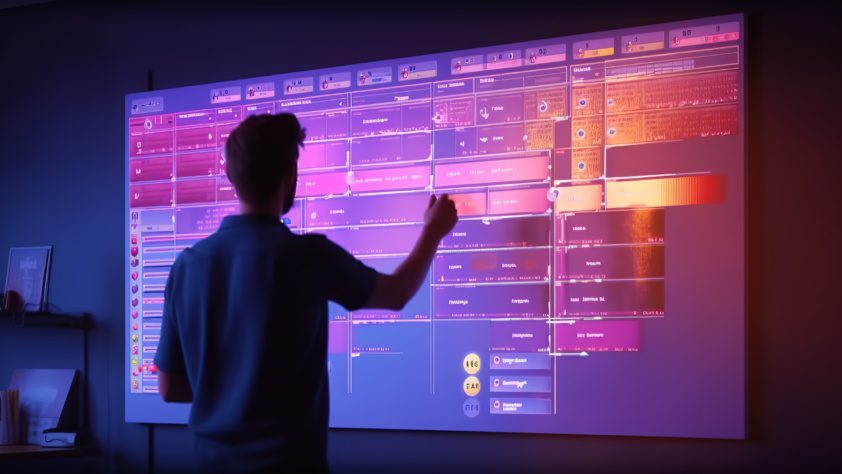The web and software development industry has an important dividing line that defines the two main components of the functionality of web solutions. Developers call these components frontend and backend. As a rule, their main difference is determined by the purpose and functionality of each of them.
In this article, we’ll take a closer look at the main difference between frontend and backend. Also, we’ll highlight the importance of their interaction in the process of creating web applications. By understanding this difference, you’ll improve your understanding of web development and its main nuances.
Unlocking the Power of Frontend Development: A Deep Dive
In fact, frontend is a web development field that is responsible for creating the graphical user interface, starting from the overall design and ending with such small things as images, graphics, buttons, etc. The front-end developer’s main purpose is to make sure that a web solution’s visual is both functional and intuitive, and stylish and pleasing to the user’s eye.
Frontend is a web development’s key component because it provides a list of tools that allow you to implement a company’s ideas about how they want to represent themselves on the Internet correctly.
To create a proper interface, the frontend developer deals with the following tools:
- Java Script is one of the most common programming languages, which is often used to add animated elements to a website and make it more dynamic and interactive.
- HTML is a standard programming language that is responsible for creating the structure of website pages.
- CSS is a language that stands for Cascading Style Sheets. It is usually used for choosing web pages format and appearance, including color scheme, fonts, etc.
The Role of a Frontend Developer: Key Responsibilities Explained
The main responsibilities of a front-end developer usually include:
- User-friendly web design creation. The front-end developer collaborates with UI developers and a web designers to choose a more visually pleasing site that would not only appeal to users, but would also shape the image of the company. A front-end developer must think carefully about the design of the interface for both PC web browsers and smartphones.
- Introducing interactive elements into the interface. As it has been already mentioned, to create an interactive and dynamic interface, the front-end developer uses Java Script and frameworks based on this language, such as Vue, React, Nuxt, etc.
- Usability check and search for system bugs. Before preparing the interface, a front-end developer must check it for system errors and fix them. After that, a developer periodically supports the operation of the interface and introduces constant updates to it.
Unveiling Backend Development: What Happens Behind the Scenes?
- PHP is considered one of the most accessible programming languages for backend developers and is often used by novice programmers. There are a large number of frameworks based on this language, including Laravel. When used correctly, PHP can provide a fast and efficient web solution.
- C#. As a rule, most often used for solutions configured for Microsoft. Also, this language allows for safer coding and ensures high solution performance.
- Python is another language best suited for novice programmers to learn because of its easy-to-read syntax. Quite often, this language is used in programming textbooks for children. Also, Python is actively used for an extensive range of industries and web solutions for them: from the social network Facebook to applications for NASA.
The Backend Developer's Toolbox: Mastering Backend Languages and Tools
- Direct site setup. A backend developer operates various frameworks, programming languages, and other tools to ensure the website’s operation, which would be understandable and convenient for the user. To put it simply, the efforts of back-end developers and the solutions they create ensure the quality of the interface.
- API development. Application programming interface development is where experts create the backend parts of the site that give users access to your web solution functionality.
- Databases and storage management. Developers work with the entire spectrum of work on databases. Starting with the fact that developers choose the type of database, depending on the type of solution and the experience of the developers themselves. The types of databases are SQL and NoSQL. Next, the developer creates a database scheme in which the structure of saving this data is thought out. Then queries and operations are developed
- Ensuring security systems. A backend developer works on authentication and authorization mechanisms to protect personal data from leaks and various attacks.
Frontend vs Backend Development: Understanding the Key Differences
First of all, front-end developers focus on the visual, visible aspects of the site. Meanwhile, backend developers work on the logic of the site, databases, systems, etc. When their efforts are combined, the end result is a quality web product.
Among the common features of both types of developers, it is necessary to have a good knowledge of coding languages in both cases. However, frontend and backend require a different set of skills, such as a different set of languages and frameworks for each of the areas mentioned above.
Nevertheless, which direction is easier and which one is more difficult? According to experts, both frontend and backend have approximately the same level of learning difficulty. However, according to British developer and content creator Alex Hyett, backend still has a lower level of complexity.
“But the hard thing about frontend development is that most of what you learn and need to know is in the framework itself,” says Hyett. “It’s knowing about the intricacies of React, and how to build applications in React, which isn’t going to be much use in 10 years time when React isn’t used anymore. Sure, the next framework will be similar, but you’re going to have to relearn a lot of those things again. If you compare that to backend development, fundamentals that you are learning aren’t going to change.”
To sum up, the main difference between frontend and backend is the focus of work. The frontend is responsible for the interface and interaction with the user, while the backend processes the data and logic of the application. The importance of understanding these areas and communication between specialists is important for successful development, ensuring the efficient work and quality of the web application. The collaboration between the frontend and the backend helps to create complex and functional web applications that meet the needs of users.



